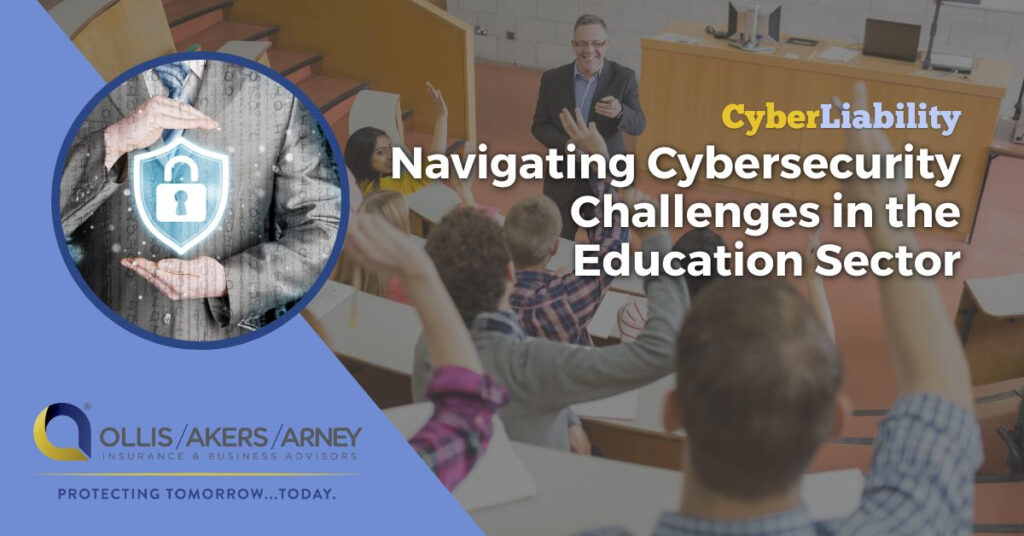Educational institutions, including K-12 schools and universities, are frequent targets of cybercriminals. These organizations often possess vast stores of sensitive data, operate with limited cybersecurity resources and rely on outdated infrastructure. As a result, cyberattacks in this sector have led to significant financial, operational and reputational damage. Given these risks, leaders at these institutions should take proactive steps to strengthen their cybersecurity posture and reduce the likelihood of data breaches and other cyber incidents.
This article explores why educational institutions are prime targets for cybercriminals, the most common types of cyberattacks in the sector, cybersecurity best practices and the growing importance of cyber insurance in mitigating risk.
Why Do Cybercriminals Target Educational Institutions?
- Valuable data—Educational institutions often process and store large amounts of sensitive personal information, including payment information, medical records, academic records, names, addresses and Social Security numbers. Colleges and universities may also engage in research that produces valuable intellectual property, making them even more attractive targets.
- Limited cybersecurity resources—Educational institutions often have tight budgets. This can lead to reduced spending on cybersecurity resources, personnel and training. This, combined with the hiring of temporary or student workers who may not receive regular cybersecurity education, may result in a weaker cybersecurity posture compared to other sectors.
- Complex IT environments—Diverse technologies, remote learning platforms, decentralized IT and personal device use can create an IT environment that allows for cyber weaknesses and an expanded attack surface. This attracts cybercriminals because they could access multiple systems through one vulnerability in the environment.
- Open network structures—Open Wi-Fi networks, a large user base and numerous external connections are common in educational settings. While these support collaboration and access, they also provide exploitable access points for cybercriminals who can then upload malware or steal data being transmitted over the network.
- Outdated technology—Many educational institutions rely on outdated technology when compared to other sectors. These tools often lack the sophisticated cybersecurity defenses that are needed to repel cyberattacks.
Common Types of Cyberattacks and Vulnerabilities
While there are multiple types of cyberattacks and vulnerabilities, the following are common in the education sector:
- Phishing and social engineering attacks involve cybercriminals manipulating users into providing sensitive information (e.g., passwords) or downloading malware through fraudulent emails, texts, calls, websites or links. The education sector often employs temporary staff and students who may not be familiar with standard internal communications. This can make phishing attacks effective, as cybercriminals can prey on this unfamiliarity and trick these individuals into revealing sensitive information or opening malicious links.
- Ransomware attacks occur when cybercriminals infiltrate an organization’s computer system, encrypt the files and demand a payment in exchange for providing a decryption key. These attacks can be effective against educational institutions because they can shut down operations, disrupt learning and result in significant financial loss. Recovery is often costly and time-consuming.
- Insider threats come from individuals with authorization to access an educational institution’s network or data, including current or former employees, who can intentionally or accidentally compromise sensitive information, sabotage systems or facilitate internal attacks. Due to their knowledge and access, these insider threats can result in severe financial, operational and reputational consequences.
- Distributed denial of service (DDoS) attacks happen when cybercriminals overload a business’s network with traffic, disrupting standard operations or causing a network outage. These attacks can lead to significant operational delays. The cybercriminals can then leverage the interruption to attempt to extort a ransom in exchange for ending the DDoS attack.
Best Practices to Strengthen Cybersecurity
To mitigate cyber risks, there are several measures educational institutions can take to safeguard their computer systems and networks, including:
- Regular software updates and patching vulnerabilities can defend against the latest cyberthreats and close off exploitable gaps.
- Strong authentication measures and access controls, such as multifactor authentication, can make it more difficult for cyber intruders to infiltrate systems.
- Ensure employees and students receive cybersecurity training so they know how to secure their devices, create strong passwords, properly spot potential cyberattacks and report issues promptly.
- Identify assets by documenting hardware, software, networks, and data to assess risks and determine where potential vulnerabilities exist so they can be addressed.
- Leverage advanced security technologies, such as artificial intelligence, machine learning and intrusion detection systems, to discover unusual activity within a system.
- Protect data by routinely backing it up and ensuring end-to-end encryption is in place.
- Partner with vendors that value cybersecurity and include cybersecurity requirement clauses in vendor contracts to help ensure cybercriminals cannot breach an educational institution’s network through a third party’s cyber defense weakness.
- Develop an incident response plan to allow for quick reactions to cyber incidents and mitigate their potential impacts.
- Conduct regular security audits and vulnerability assessments to find weak points in networks and systems before hackers exploit them.
- Vet employees and foster a culture of security, where employees are encouraged to report suspicious activity.
- Segment networks to limit malicious actors’ lateral movements within the network if they access it.
The Role of Cyber Insurance in Mitigating Risk
Cyberattacks can still occur even with robust defenses in place. Securing cyber insurance can help educational institutions mitigate exposure to cyber-related damages. It is specifically designed to cover financial losses that result from cybersecurity incidents and operational interruptions. Cyber insurance can help fill gaps left by other policies (e.g., general liability insurance), which generally do not cover cyber-related events.
Additionally, many cyber insurance policies provide access to a vendor panel that includes legal counsel, public relations firms, IT specialists and other experts experienced in managing cyber incidents. These resources can assist educational institutions in responding quickly and effectively, mitigating the impact of a cyberattack. Cyber insurance policies vary in coverage, limits and exclusions, and it is advisable to consult a licensed insurance professional for assistance in choosing a policy that best suits an educational institution’s needs.
Conclusion
Cyberattacks are a serious threat to the education sector. Malicious actors have many motives for targeting educational institutions, and they employ several methods to compromise data, steal information or disrupt computer networks. Strong cybersecurity practices with the proper cyber insurance policy are crucial to address this risk. By being proactive, leaders in the education sector can mitigate this exposure and protect their finances, operations and reputations.
Contact us today for more information.
Courtesy of Ollis/Akers/Arney Insurance & Business Advisors
This Cyber Risks & Liabilities document is not intended to be exhaustive nor should any discussion or opinions be construed as legal advice. Readers should contact legal counsel or an insurance professional for appropriate advice. © 2025 Zywave, Inc. All rights reserved.


